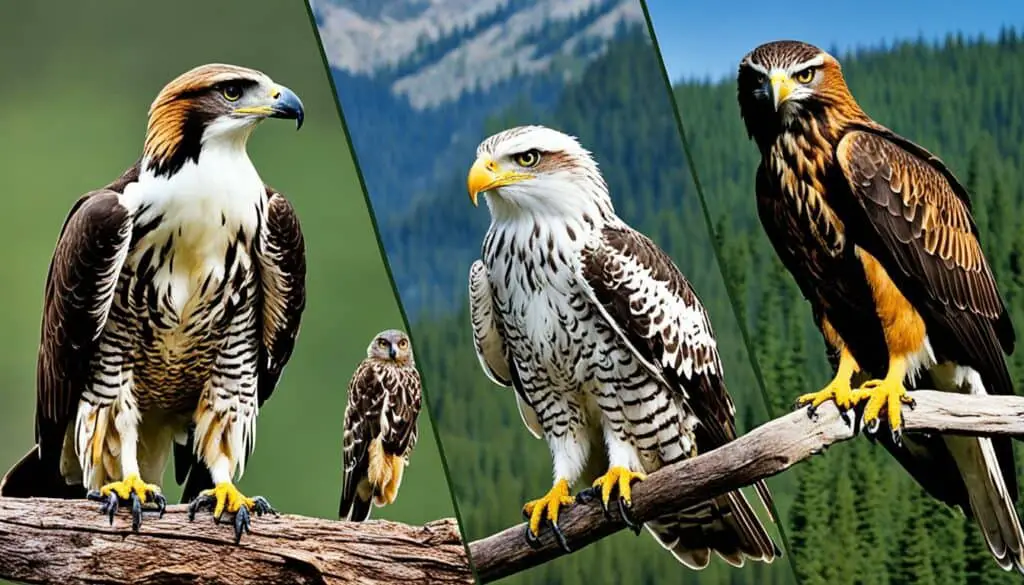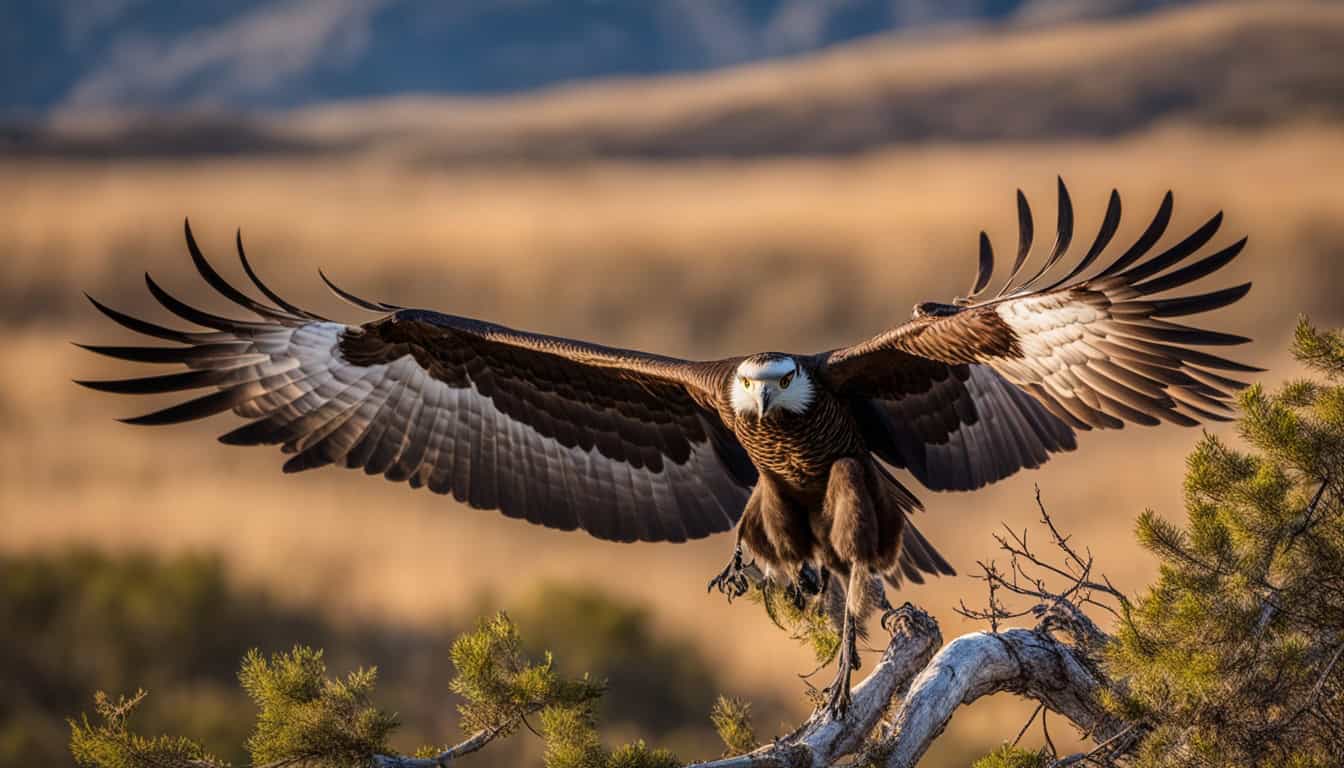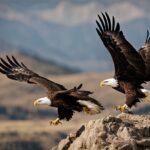Birds of prey are key to a healthy ecosystem. The USA’s largest one draws fascination from bird watchers and nature lovers. They rule various North American habitats with their hunting and flying skills. Protecting these majestic birds is crucial for the ecosystem’s balance.
Introduction to Birds of Prey in the USA
USA raptors offer a wide range of species known for unique traits and hunting techniques. They’re not just interesting for their looks but also for their role in nature and keeping a healthy eco-balance. Two well-known birds are the Bald Eagle and the Golden Eagle. They are famous for their size, power, and their ability to impress everyone who watches birds, even those who don’t.
When you dive into the world of raptors, you’ll see a big variety. They are grouped by how they look and how they hunt. Though owls and some vultures are also birds of prey, the focus is mostly on those that hunt in daylight. These top predators use their sharp eyes, strong claws, and beaks to hunt effectively when the sun is out.
| Species | Notable Characteristics | Importance in Culture |
|---|---|---|
| Bald Eagle | Large size, strong build, nesting near water | National symbol of the USA |
| Golden Eagle | Powerful talons, exceptional speed, wide wingspan | Admired for hunting prowess and cultural significance |
For people who love watching wildlife, raptors are a thrilling sight. They rule the sky with their hunting features. This makes them a key part of wildlife tours and saving natural spaces. Seeing an eagle soar or a falcon swiftly dive shows us the pure power and beauty of Earth’s creatures.
California Condor: The Largest Bird in North America
The California Condor is the biggest bird in North America. It’s famous for its huge wings and its critical place in the ecosystem. This majestic bird shows how wildlife and efforts to save them are both important.
Physical Characteristics
This bird has amazing features. It can have a wingspan of 3 meters and weigh up to 12 kgs. With these traits, it’s not just beautiful to see but also important for science to study large birds.
Diet and Habitat
The California Condor mainly eats dead animals. It prefers deer, cattle, and rodents. It lives in various places like rocky areas, forests, and savannas. Its ability to live in different places shows how important it is to keep natural areas varied.
Conservation Status
In the past, the California Condor almost disappeared in the 1980s. But, with hard work in conservation, especially breeding and release programs, their numbers have improved. This shows that efforts to save endangered species are very important.
| Aspect | Details |
|---|---|
| Wingspan | Up to 3 meters (9.8 feet) |
| Weight | Up to 12 kgs (26.6 lbs.) |
| Diet | Carrion |
| Habitat | Rocky shrubland, coniferous forests, oak savannas |
| Conservation Status | Endangered |
Golden Eagle: A Majestic Raptor
The Golden Eagle symbolizes strength and beauty, known for its stunning appearance and hunting skills. It lives mainly in the western U.S. and parts of the North. They do well in many places, from open fields to high mountains.
Size and Wingspan
One key feature of the Golden Eagle is its size. It has a wingspan of about 79 inches and weighs around 10 pounds. This makes it one of the biggest birds of prey. Its size helps it be a top hunter in its area.
Hunting Behavior
Golden Eagles use their speed and agility to hunt many kinds of prey. They eat small animals like rabbits and big ones like pronghorns. They are known for their high patience and accuracy. This lets them hunt by flying high and then diving quickly for their target.
Distribution and Range
Golden Eagles live over a large area, mostly in the western U.S. They prefer open spaces where they can easily see their prey from above. Their homes can be dry deserts or high mountains, showing how adaptable they are.
It’s important to work on protecting these amazing birds. As we learn more about them, it’s vital we keep them in the wild. This requires focused conservation efforts.
The Role of Raptors in the Ecosystem
Raptors are key to keeping the balance in nature with their sharp hunting skills and eyesight. They are top predators, which means they control the number of small animals, birds, and reptiles. By hunting, they keep any one type of animal from taking over. This helps keep the ecosystem rich with different life forms.
In the world of wildlife ecology, raptors are like health checks for the environment. When there are many raptors, it usually means the ecosystem is healthy and diverse. But if they start to disappear, it could show that things are not going well. This alerts people to take steps to protect their habitats.
Raptors also play a part in making their prey stronger and fitter. When these big birds are around, animals they hunt have to get better at surviving. This, in turn, can lead to more stable animal populations. Understanding the role of raptors helps us all see the importance of keeping our ecosystems in balance. We should all work to protect these critical parts of nature.
Bald Eagle: Symbol of Freedom
The Bald Eagle stands proud as the U.S. national emblem. It’s a symbol of freedom and might. With an 80-inch wingspan, it can awe anyone. This bird weighs just under 10 lbs and is 31 inches long.
It loves to eat fish. You’ll often see it hunting around water bodies like lakes. Its flight and hunting skills are truly elegant and powerful.
You can spot Bald Eagles in every U.S. state, Canada, and Mexico. Efforts to protect them have made a big difference. Raptor protection has helped their numbers grow again after they faced threats from people and habitat loss.
| Attribute | Value |
|---|---|
| Wingspan | 80 inches |
| Length | 31 inches |
| Weight | Under 10 lbs |
| Primary Diet | Fish |
| Habitat Range | Continental USA, Canada, Mexico |
The Bald Eagle is not just a beautiful bird. It plays a big role in protecting our environment. Raptor protection efforts continue to support these birds. They stand as a proud symbol of both our nation and our care for nature.
Comparing the Largest Birds of Prey
Looking into the lives of the biggest birds of prey is fascinating. We get to see their size, wingspan, how they hunt, what they eat, and where they live. Let’s dive into the lives of these amazing hunters.

Weight and Wingspan
The Andean Condor has a huge wingspan of up to 10.5 feet. It’s known for being very heavy, weighing up to 33 pounds. In comparison, the California Condor’s wingspan is about 9.8 feet. The Golden and Bald Eagles are lighter, with wingspans of 79-80 inches, and they weigh around 10 pounds. This shows how each bird is built differently for their lifestyle.
Hunting and Feeding Patterns
These birds hunt and eat in very different ways. The Andean and California Condors mainly eat dead animals. They keep the environment clean by getting rid of these. On the other hand, the Golden Eagle hunts live animals, from rabbits to pronghorns. The Bald Eagle is a great fisher, using its sharp talons to catch fish. Their varied diets show how adaptable and important they are in their ecosystems.
Geographical Distribution
Where these birds live shows how adaptable they are to different places. The Andean Condor is found in the South American Andes. The California Condor lives in a variety of North American landscapes. The Golden Eagle can be found across the open lands of the northwestern United States. The Bald Eagle prefers to live near water and can be seen from Canada to Mexico. This range of habitats tells us a lot about their importance in various ecosystems.
Endangered Status and Conservation Efforts
It’s critical to know the challenges facing endangered raptors for them to survive. Birds like the California Condor and the Andean Condor are at risk. They face threats like losing their homes, getting poisoned, and being hunted illegally.
Many efforts are being made to help these birds. Special programs, including breeding in captivity, are helping to increase their numbers. Laws banning harmful lead bullets are lowering poisoning cases.
Protecting places where these birds live is very important too. People are working hard to keep their natural homes safe. It ensures these endangered raptors can find good places to live. Everyone’s teamwork locally and worldwide helps a lot.
Learning about efforts to save these birds is key. Every bit of help matters, from supporting projects to learning how to protect wildlife. Together, we can make a big difference. The future can be bright for these amazing birds with our help.
What is the largest bird of prey in the USA?
The California Condor holds the title for the USA’s largest bird of prey. It boasts a wingspan of almost 10 feet. This shows how powerful conservation work is, helping these birds grow in number.
This bird is very special among its kind. Once almost gone forever, they made a big comeback thanks to focused efforts. Now, their majestic size and the way they fly draw many to admire them.
These birds owe their return to safe places to efforts focused on their homes. Creating laws to stop harmful things and breeding them in safety were part of this success. The story of how they made a return is truly inspiring.
Here is how the California Condor compares to other top North American raptors:
| Avian Predator | Wingspan (feet) | Weight (pounds) | Diet | Habitat |
|---|---|---|---|---|
| California Condor | 9.8 | 26.6 | Carrion | Rocky shrubland, coniferous forests, oak savannas |
| Golden Eagle | 6.6 | 10 | Small mammals, larger mammals | Open landscapes, semi-open areas |
| Bald Eagle | 7.5 | 10 | Fish, small mammals | Near bodies of water, various habitats |
Interesting Facts About Large Raptors
Large raptors are amazing to wildlife fans because of their huge size and interesting actions. Check out some cool bird of prey trivia.
Among the numerous raptor facts, the Harpy Eagle’s talons are particularly notable. Comparable in size to a grizzly bear’s claws, these talons allow the Harpy Eagle to capture and subdue large prey effortlessly.
The Golden Eagle is famous for its high-speed dives. This incredible bird can dive at speeds nearly reaching 200 miles per hour to catch its prey. With this jaw-dropping ability, the Golden Eagle is among the Earth’s quickest animals.
- The Wandering Albatross holds the record for the largest wingspan of any bird, stretching up to an incredible 11 feet. This expansive wingspan enables it to travel vast distances over open oceans, often without needing to land for days.
These stories show the amazing variety and strength of large raptors. They are a favorite of those who love nature. Each of these birds shows the powerful and resilient nature of these predators in the wild.
| Raptor | Unique Fact |
|---|---|
| Harpy Eagle | Talons comparable in size to a grizzly bear’s claws |
| Golden Eagle | Can dive at speeds close to 200 miles per hour |
| Wandering Albatross | Largest wingspan of any bird at up to 11 feet |
Conclusion: The Majesty of America’s Largest Predatory Birds
America’s biggest predatory birds, like the California Condor and the Golden Eagle, are nature’s marvels. They amaze us with their big wings and special ways of hunting. These raptors are important for keeping the environment healthy. The beauty of these birds isn’t just in how they look. It’s also in what they do for nature and the deep meaning they have in different societies.
The California Condor has a story that feels like a legend. It’s known for its huge wings and how it almost disappeared but then came back. This shows how protective efforts can succeed. The Golden Eagle is a symbol of strength and survival because of its impressive hunting skills. Both these birds show why we need to protect and admire wildlife.
Seeing the grace and power in these birds is amazing. But, it’s important to know that keeping them safe is crucial. With ongoing study and conservation work, we can ensure that later generations also get to enjoy seeing these birds. We all have a part in making sure the skies stay open for these impressive creatures. This helps keep America’s animal world rich and varied.
FAQ
What is the largest bird of prey in the USA?
The title goes to the California Condor in the USA. It can span its wings up to 9.8 feet. Its weight can reach up to 26.6 lbs.
What are some characteristics of birds of prey in the USA?
Birds of prey have sharp talons, super eyesight, and powerful beaks. They help keep the ecosystem in check by hunting small animals. This includes mammals, birds, and reptiles.
What is the diet and habitat of the California Condor?
This bird mainly eats carrion, which is dead animals. It prefers areas like rocky shrubland and coniferous forests. You can also find it in oak savannas.
What conservation status does the California Condor hold?
The California Condor faces a critical threat of extinction. But efforts like captive breeding and protecting its habitat have helped. These efforts have brought the bird away from the edge of extinction.
How large is the Golden Eagle?
The Golden Eagle has an impressive wingspan of about 79 inches. It weighs around 10 lbs. Its big size and hunting skills make it stand out.
What are the hunting behaviors of the Golden Eagle?
This eagle is a mighty hunter. It hunts many prey types, from rabbits to pronghorns. It’s known for being fast and agile while hunting in the air.
Where can the Golden Eagle be found?
In North America, it mostly lives in the western United States. It likes living in open and semi-open lands.
How important are raptors to the ecosystem?
Raptors, at the top of the food chain, are key to ecosystem balance. They help by controlling the population of their prey. The health of their environments often depends on them.
What are the Bald Eagle’s characteristics?
The Bald Eagle symbolizes the United States. It has a wingspan of about 80 inches and a length of 31 inches. It weighs nearly 10 lbs and eats mostly fish. You can find it near water all over North America.
How do the largest birds of prey compare in terms of weight and wingspan?
The Andean Condor tops them all. It has a wingspan up to 10.5 feet and weighs 33 pounds. The California Condor, Golden Eagle, and Bald Eagle are also large. Each one’s size helps it thrive in its specific environment.
What are the typical hunting and feeding patterns of these large raptors?
Large raptors hunt and eat in different ways. For example, the Golden Eagle goes after live prey. But the California Condor mainly feeds on dead animals. Their habits match their roles in the environment and how they’ve evolved.
What geographical distribution do the largest birds of prey in the USA have?
These birds live in many parts of North America. The California Condor likes rocky and wooded places. The Bald Eagle prefers areas near water. And the Golden Eagle does well in open lands, especially in the western United States.
What conservation efforts are in place for endangered raptors?
Work to protect these birds includes breeding programs and saving their habitats. Laws have also been made to stop things like lead poisoning. These steps have helped birds like the California Condor bounce back from the brink of disappearing.
What are some interesting facts about large raptors?
Large raptors have some amazing traits. A Harpy Eagle’s talons are as big as a grizzly bear’s. Golden Eagles can dive at almost 200 miles per hour. And the Wandering Albatross has the biggest wingspan of any bird, up to 11 feet.







